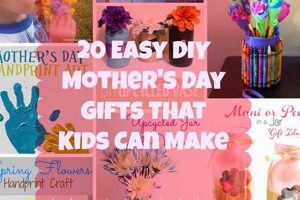Handcrafted presents for a paternal or maternal grandparent represent a thoughtful category of personalized items. These items are typically created by the grandchild or other family member, often requiring effort and creativity rather than significant monetary investment. For instance, a painted birdhouse, a framed family photo collage, or a knitted scarf are all examples.
The value of self-made presents lies primarily in the personal connection and effort invested, conveying affection and demonstrating consideration for the recipient’s interests. These gifts can evoke sentimental feelings and become treasured keepsakes. Historically, homemade presents were more common due to limited access to commercially produced goods; however, their appeal endures due to the unique character they possess.
Subsequent sections will explore specific project ideas suitable for various skill levels, detail material sourcing suggestions, and outline ways to personalize these creations to ensure meaningful and appreciated results.
Guidance for Handcrafted Grandfather Presents
The following recommendations serve to enhance the creation and reception of personally crafted items intended as gifts for grandfathers.
Tip 1: Tailor to the Individual: Consider the recipient’s hobbies, interests, and existing possessions to ensure the resulting item is both useful and appreciated. An avid gardener may value a custom-built planter box, while a reader might prefer a personalized bookmark.
Tip 2: Prioritize Quality Over Complexity: A well-executed, simple project is generally preferable to an ambitious undertaking fraught with errors. Focus on achieving a polished finish and demonstrating attention to detail, regardless of the project’s scale.
Tip 3: Incorporate Personal Touches: Embellishments such as engraved names, dates, or meaningful quotes can significantly enhance the sentimental value of the finished item. These additions transform a generic object into a unique and cherished memento.
Tip 4: Safety First: When selecting materials and tools, prioritize safety to minimize the risk of injury. Supervise children closely during their participation in crafting projects, and ensure proper ventilation when using paints, adhesives, or other potentially hazardous substances.
Tip 5: Plan Ahead: Allot ample time for material procurement, project execution, and any necessary finishing touches. Rushing the process can compromise the quality of the final product and lead to unnecessary stress.
Tip 6: Presentation Matters: Thoughtful wrapping and presentation elevate the perceived value of the hand-created item. Consider using personalized wrapping paper, ribbons, or gift tags to enhance the overall gifting experience.
The aforementioned recommendations provide a framework for creating presents that are not only personalized but also demonstrate care and consideration. The resulting items can serve as lasting reminders of familial affection.
The subsequent section will provide ideas about how to ensure the lasting nature of self-made grandfather presents.
1. Personalization
Personalization, in the context of handcrafted presents intended for grandfathers, transforms a generic item into a unique symbol of familial connection, enhancing its emotional resonance and perceived value.
- Incorporation of Hobbies and Interests
Personalizing an item to reflect a grandfather’s specific hobbies or interests demonstrates thoughtful consideration. For example, a hand-painted fishing lure box, a custom-designed bookend for a favorite author, or a knitted golf club cover directly ties the gift to his passions, increasing its utility and sentimental appeal.
- Integration of Names, Dates, and Locations
The addition of names, significant dates (birthdays, anniversaries), or geographical locations with personal meaning adds a layer of individualized value. An engraved wooden picture frame featuring the names of grandchildren, a calendar marking important family events, or a map highlighting places visited together creates a tangible connection to shared memories.
- Use of Family Photos and Imagery
Incorporating family photos or personalized imagery provides a visual representation of familial bonds. A photo collage mounted on a wooden plaque, a customized mug featuring grandchild artwork, or a digitally printed blanket showcasing family vacations transforms everyday items into cherished keepsakes.
- Adaptation to Physical Limitations
Personalization extends beyond aesthetic considerations to include adaptations that address potential physical limitations. A large-button remote control with personalized labels, an easy-grip gardening tool, or a customized walking stick designed for comfort and stability demonstrates concern for the recipient’s well-being and enhances the gift’s practicality.
The preceding facets illustrate that personalization within the realm of handcrafted presents elevates the act of gift-giving beyond mere material exchange, fostering stronger emotional connections and creating lasting reminders of familial affection. The thoughtful incorporation of individualized elements transforms the presentation into a tangible expression of love and appreciation.
2. Practicality
The concept of practicality is central to the creation of self-made presents for grandfathers. A focus on utility ensures the resulting item is not merely a decorative object but serves a functional purpose within the recipient’s daily life, increasing its long-term value and appreciation.
- Alignment with Hobbies and Interests
A self-made gift is most practical when it directly supports a grandfather’s existing hobbies or interests. A handcrafted birdhouse provides shelter for birds for the individual interested in birdwatching; a personalized tool organizer assists those engaged in woodworking or home repair. The items usefulness guarantees it sees frequent use.
- Enhancement of Daily Routine
Practical presents can also simplify or improve aspects of a grandfather’s daily routine. Examples include a large-print calendar for individuals with impaired vision or a custom-built ramp to assist with mobility issues. These items contribute directly to the ease and comfort of daily living.
- Provision of Storage or Organization
Items designed to provide storage or enhance organization represent a highly practical gifting option. A handcrafted wooden box for storing keepsakes, a personalized bookshelf for organizing literature, or a custom-built rack for displaying collectables offer tangible benefits in terms of spatial efficiency and accessibility.
- Adaptation to Physical Needs
Thoughtful presents address specific physical needs, exemplifying high degrees of practicality. This could include adapted utensils for individuals with arthritis, a customized reading stand to alleviate neck strain, or a walking stick designed for improved balance and stability. These gifts prioritize the recipient’s well-being and comfort.
The facets detailed above demonstrate that incorporating practicality into the creation of self-made presents transforms a sentimental gesture into a tangible asset. By focusing on the recipient’s needs, interests, and daily routines, the resulting items become valued components of their lives, reinforcing the bond between giver and receiver.
3. Material Selection
Material selection exerts a direct influence on the quality, longevity, and perceived value of a self-made present intended for a grandfather. The choice of materials impacts the aesthetic appeal, structural integrity, and suitability for the intended purpose. Selecting inappropriate materials can lead to premature failure, detract from the gift’s visual appeal, and undermine its overall impact. For example, using softwood for a garden bench intended for outdoor use would likely result in rapid deterioration, rendering the gift impractical. Conversely, employing weather-resistant hardwood ensures durability and extends the lifespan of the item.
Considerations beyond mere durability extend to the grandfather’s potential sensitivities and preferences. The selection of hypoallergenic fabrics for a hand-sewn quilt or the use of non-toxic paints and finishes for a wooden toy demonstrate thoughtful consideration for the recipient’s well-being. Furthermore, utilizing materials that align with the grandfather’s personal aesthetic, such as reclaimed wood for a rustic-style picture frame or specific types of yarn for a knitted scarf that reflect his preferred color palette, enhances the gift’s personal significance.
In conclusion, judicious material selection is paramount in creating self-made presents that are both aesthetically pleasing and functionally sound. The understanding of material properties, combined with a consideration of the recipient’s needs and preferences, is crucial for ensuring the creation of gifts that are cherished for their quality and thoughtful design. Failure to prioritize material selection can compromise the overall impact of the handcrafted item, diminishing its intended sentimental value. Prior material research can make a massive difference for the success of a self-made present.
4. Skill Level
The requisite proficiency for crafting personalized items for grandfathers exerts a significant influence on project selection and outcome. There exists a direct correlation between the complexity of a project and the level of skill necessary for successful execution. A mismatch between skill level and project demands can lead to frustration, substandard results, and a diminished sentimental value of the finished item. Novice crafters might reasonably undertake simpler projects such as painting a flower pot or assembling a photo collage. Conversely, more intricate endeavors such as woodworking or knitting require greater experience and technical knowledge. For example, a beginner attempting to build a complex model airplane without sufficient skill may produce a fragile, aesthetically unappealing item, negating its intended emotional impact.
Consideration of skill level extends to material handling and tool usage. Mastery of specific techniques, such as soldering or wood carving, dictates the feasibility of incorporating certain design elements. In situations where the crafter lacks the necessary expertise, enlisting the assistance of a more skilled individual or opting for a simplified design becomes essential. Moreover, proper tool handling is paramount not only for achieving desired results but also for ensuring safety. Attempting to use power tools without adequate training can result in injury and project damage.
In summary, a realistic assessment of skill level is crucial for the successful creation of handcrafted presents. Proper project selection, adaptation of design complexity, and utilization of appropriate tools and techniques contribute to a more satisfying and rewarding crafting experience. By acknowledging and respecting the limits of one’s skillset, the crafter maximizes the likelihood of producing a personalized item that is both aesthetically pleasing and emotionally meaningful for the recipient. Choosing achievable projects increases enjoyment and decreases the risk of uncompleted presents.
5. Time Investment
The allocation of time is a crucial determinant in the creation of handcrafted presents. The investment of time directly influences the quality, intricacy, and perceived value of the finished item. Insufficient time allocation often results in rushed execution, compromised quality, and diminished sentimental impact. Conversely, adequate time investment allows for meticulous attention to detail, refined craftsmanship, and a personalized outcome that reflects genuine care and effort.
- Project Planning and Design
Dedicated time for project planning and design is paramount. This stage involves researching suitable projects, sketching preliminary designs, acquiring necessary materials, and assessing skill requirements. Rushed planning can lead to overlooked details, material shortages, and ultimately, a poorly executed project. Thoughtful planning ensures efficient use of resources and minimizes potential errors.
- Crafting and Construction
The actual crafting and construction phase necessitates careful time management. Complex projects demand a significant time commitment, often spread over multiple sessions. Rushing through this stage can compromise structural integrity and aesthetic appeal. Allowing ample time for precise cutting, gluing, sewing, or painting ensures a polished and professional finish. For instance, complex woodworking project needs proper time.
- Personalization and Embellishment
Personalization and embellishment represent an opportunity to infuse the present with individual character and sentimental value. This stage often requires painstaking attention to detail, such as hand-painting intricate designs, engraving names or dates, or adding meaningful embellishments. Investing sufficient time in this process elevates the gift from a generic item to a cherished keepsake.
- Finishing and Presentation
The final stages of finishing and presentation significantly impact the overall impression of the handcrafted present. This includes tasks such as sanding rough edges, applying protective finishes, and carefully wrapping the item for presentation. Rushing through these steps can detract from the overall quality. Thoughtful presentation, such as using personalized wrapping paper or adding a handwritten card, enhances the emotional impact of the gift.
In summary, time investment is an essential element in the creation of handcrafted presents intended for grandfathers. The allocation of adequate time for planning, crafting, personalization, and presentation results in a higher-quality, more meaningful gift that reflects genuine care and appreciation. Conversely, insufficient time investment can compromise the quality and diminish the emotional impact of the finished item. Therefore, careful time management is crucial for ensuring a successful and rewarding crafting experience.
6. Sentimental Value
Sentimental value, in the context of handcrafted presents for grandfathers, represents the intangible emotional worth attached to an object by virtue of its association with personal history, affection, and shared experiences. This value often transcends the object’s intrinsic material worth, imbuing it with a significance that resonates deeply with both the giver and the recipient.
- Reflection of Shared Memories
Gifts incorporating elements that evoke shared memories possess heightened sentimental value. For instance, a scrapbook filled with photographs from family vacations, or a hand-painted depiction of a cherished family pet, creates a tangible link to past experiences, fostering a sense of nostalgia and connection. The item serves as a constant reminder of positive shared moments, strengthening familial bonds.
- Expression of Affection and Care
Handcrafted presents inherently convey a sense of affection and care due to the time and effort invested in their creation. The deliberate act of crafting a gift signifies a personal commitment that transcends the mere purchase of a commercially available item. This investment of effort translates into emotional value, demonstrating a genuine desire to create something meaningful for the recipient. The act of hand-making emphasizes consideration and attentiveness.
- Symbol of Familial Connection
Handcrafted presents can serve as tangible symbols of familial connection, reinforcing the bonds between generations. A knitted blanket passed down through the family, or a hand-carved wooden toy created for a grandchild, becomes a cherished heirloom, representing the continuity of family history and traditions. The item transcends its functional purpose, becoming a potent symbol of enduring familial relationships. These items tell stories and reinforce identities.
- Unique and Irreplaceable Nature
The unique and often irreplaceable nature of handcrafted presents contributes significantly to their sentimental value. Unlike mass-produced items, each self-made present possesses individual imperfections and distinctive characteristics that render it one-of-a-kind. This uniqueness enhances its perceived value, transforming it from a mere object into a personalized artifact that cannot be replicated. The singularity emphasizes the intent and focus.
The preceding facets illustrate the multifaceted nature of sentimental value within the realm of hand-created items for grandfathers. These presents, imbued with personal history, affection, and familial connection, transcend their material worth, becoming cherished keepsakes that strengthen familial bonds and evoke positive memories. The act of crafting a gift transforms it into a powerful symbol of enduring love and appreciation, ensuring its lasting significance for both the giver and the recipient. The impact of these items is long lasting.
7. Presentation
The manner in which a handcrafted present is presented significantly impacts its perceived value and the emotional response it elicits. Presentation transcends mere aesthetics, encompassing the care and thoughtfulness communicated through wrapping, packaging, and accompanying sentiments.
- Wrapping and Packaging
The selection of appropriate wrapping materials and packaging is crucial. Personalized wrapping paper featuring family photos, or the use of a handcrafted wooden box, elevates the gift beyond its functional purpose. The packaging should reflect the effort invested in the creation of the present itself, enhancing the overall impression. Sloppy or inadequate wrapping can detract from the perceived value, regardless of the quality of the item within.
- Accompanying Card or Note
A handwritten card or note adds a personal touch that reinforces the sentiment behind the gift. The message should express sincere appreciation and highlight the specific qualities of the present that are tailored to the recipient’s interests or needs. Avoid generic or impersonal greetings; instead, focus on conveying genuine affection and thoughtful consideration. For example, notes may explain some part of your intention for him to understand more.
- Timing and Context of Delivery
The timing and context of gift delivery can significantly influence its impact. Presenting the gift during a meaningful occasion, such as a birthday, anniversary, or family gathering, enhances its emotional resonance. Conversely, presenting the gift casually or without proper context may diminish its perceived importance. Consider the recipient’s personality and preferences when choosing the appropriate setting for delivery.
- Verbal Expression of Sentiment
Accompanying the physical gift with a verbal expression of sentiment further reinforces its emotional impact. Sharing a heartfelt anecdote about the creation of the present, or expressing specific reasons why it was chosen for the recipient, adds a personal touch that transcends the material object. Sincere and genuine words enhance the overall gifting experience and strengthen familial bonds.
In essence, the presentation of a handcrafted present is not merely an afterthought but an integral component of the gifting process. By carefully considering wrapping, packaging, accompanying sentiments, timing, and verbal expression, the giver maximizes the emotional impact and ensures the present is received with the appreciation and joy it deserves. Thoughtful presentation elevates a simple gift to a cherished expression of love and connection.
Frequently Asked Questions Regarding Handcrafted Grandfather Presents
The following section addresses common inquiries concerning the creation and selection of self-made gifts intended for grandfathers. These responses aim to provide clarity and guidance for individuals undertaking such projects.
Question 1: What types of materials are best suited for handcrafted presents intended for outdoor use?
Durable, weather-resistant materials are essential for items designed for outdoor environments. Options include treated lumber, weather-resistant hardwoods (e.g., cedar, teak), rust-proof metals (e.g., stainless steel, aluminum), and exterior-grade paints and sealants.
Question 2: How can the complexity of a handcrafted project be adjusted to suit varying skill levels?
Project complexity can be scaled by simplifying designs, reducing the number of intricate steps, utilizing pre-cut materials, and focusing on mastering fundamental techniques. Beginners should prioritize simple projects with clear instructions.
Question 3: What are some effective methods for personalizing a handcrafted present?
Personalization can be achieved through engraving names or dates, incorporating family photos, selecting materials that reflect the recipient’s hobbies or interests, and adapting the design to address specific physical needs or preferences.
Question 4: How can the durability of a handcrafted present be enhanced?
Durability is enhanced through careful material selection, proper construction techniques, the application of protective finishes (e.g., sealants, varnishes), and reinforcement of weak points with adhesives or fasteners.
Question 5: What are some common mistakes to avoid when creating handcrafted presents?
Common errors include rushing the process, failing to plan adequately, selecting inappropriate materials, attempting projects beyond one’s skill level, neglecting safety precautions, and overlooking finishing details.
Question 6: How can the sentimental value of a handcrafted present be maximized?
Sentimental value is maximized by incorporating elements that evoke shared memories, expressing genuine affection and care, creating a tangible symbol of familial connection, and ensuring the present is unique and irreplaceable.
In conclusion, the successful creation of handcrafted presents requires careful consideration of materials, skill level, personalization, durability, potential pitfalls, and sentimental impact. Addressing these factors ensures the resulting item is both aesthetically pleasing and emotionally meaningful.
The subsequent section will summarize the overarching principles discussed throughout this article.
DIY Grandfather Gifts
This exposition has detailed the multifaceted nature of personally crafted presents intended for grandfathers. The discussion has encompassed project personalization, practicality considerations, material selection criteria, required skill levels, appropriate time investment, amplification of sentimental value, and refinement of presentation techniques. Emphasis has been placed on the confluence of these elements in generating meaningful and lasting items.
Given the detailed analyses presented, individuals should now possess an enhanced understanding of the requisite effort and strategic planning necessary to realize successful “diy grandfather gifts”. The pursuit of such endeavors, when undertaken with diligence and a genuine spirit of affection, fosters deeper familial bonds and creates tangible legacies of care. Further exploration of advanced crafting techniques and innovative design concepts is encouraged to continually elevate the art of personalized gift-giving.







